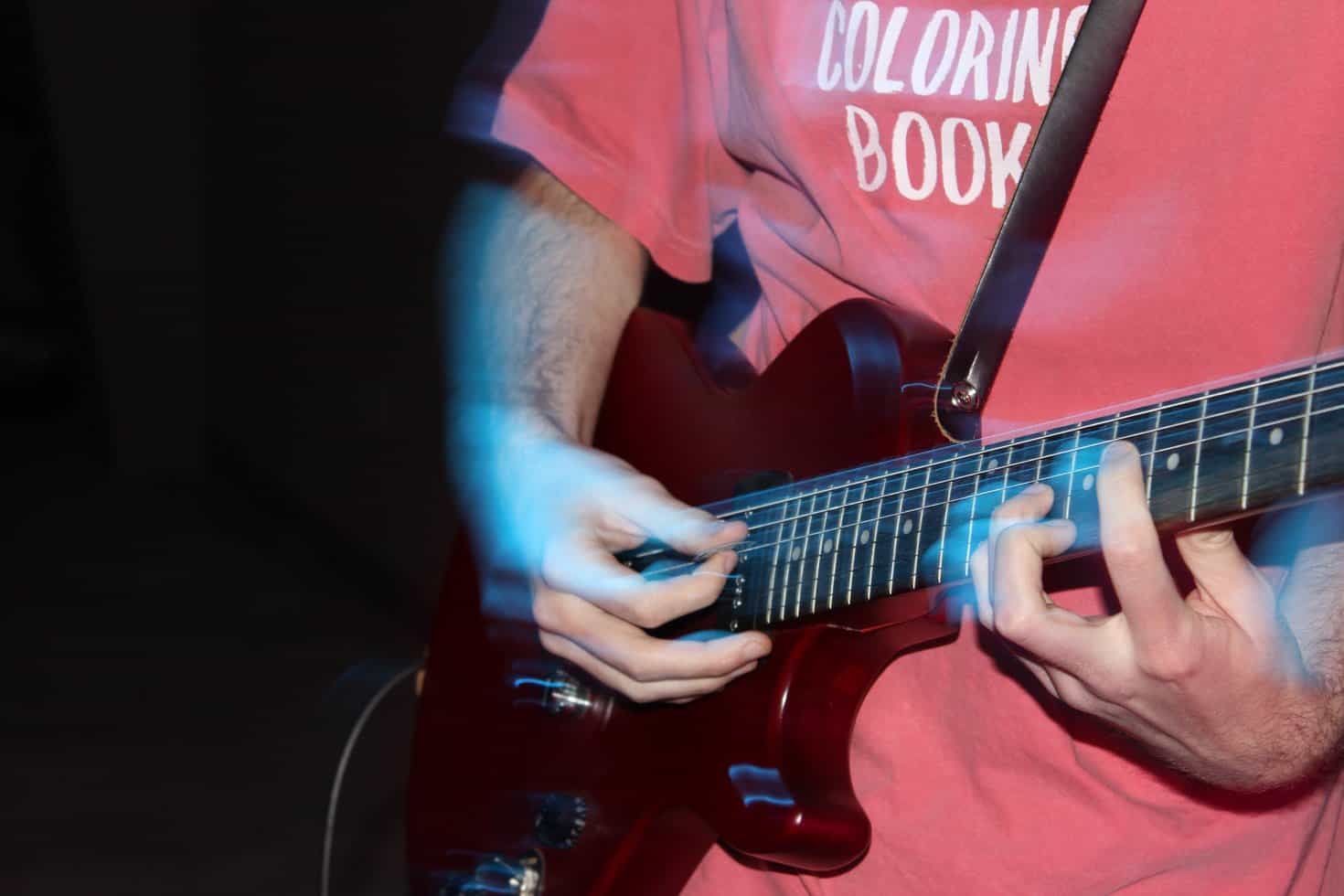Want to know how dreams turn into nightmares?
The picture this.
You get the great news that you’ll open a show for a huge band.
Fantastic! You practice your songs and play your fingers to the bone.
You rehearse non-stop with your band for months.
Finally, the long-awaited day arrives. You feel slightly nervous but deep inside know you are well prepared.
Nothing can go wrong.
Hitting the stage fills you with adrenaline.
You strike the first chord with all your might… but break a string.
In just two seconds, all that joy disappears.
This moment will drag you down for years to come.
You’ll never forget this experience, but you wish you could.
Now, let’s leave tragedy aside and focus on solutions.
What can you do under such circumstances?
If a string breaks during a show, simply stop playing and replace it. You can have a backup guitar as well. It is important to arrange a plan B with your band to know what to do. Lastly, avoid playing for the sake of it. It is better not to play than to play wrong.
This article will prepare you for an inevitable event. It is up to you whether it will catch you off guard, or equipped with a solution.
Always have a spare set of strings nearby
Chaos is ungraspable.
This means that it’s not your fault if you break a string on stage.
However, you are absolutely responsible for having an extra set of strings for replacing the one you broke.
After all, it’s the simplest solution to the problem.
Simply take the string that needs to be replaced, and change it.
It takes less than five minutes.
Still, there is another form of solving it, less simple, but even better and quicker.
A spare guitar will be even better
Why change a broken string when you can switch them all at once?
Yes, I know that bringing another guitar to the show could be rather complicated.
I mean, it’s already a mess to travel with one guitar, let alone two!
However, it’s not as crazy as it sounds.
It takes less time to change and turn back on a guitar than to change a string.
That way, you prevent the audience from getting bored or distracted.
Check if your guitar is still in tune
Having a string broken is the least of your problems.
After all, we already covered some solutions for it.
In fact, the real issue under such a situation would be related to tuning.
Most often than not, when a guitar string breaks, the other strings go out of tune.
This is a huge mess because of two main reasons.
First, it stops being a matter of changing one string. Now it becomes even more time-consuming because you have to take care of the whole string set.
Second, playing an out-of-tune guitar is, by far, worst than playing nothing at all.
A song without guitars sounds better than one with a detuned guitar. No doubt about it.
Now, the question is, why does this happen?
On some guitars, strings terminate in a spring-loaded tremolo, which balances the bridge so the guitar can be played without problems.
The entire string tension stabilizes the spring tension behind the body.
So, when one of those strings breaks, the tension on the rest must balance the spring tension.
This tends to be the case on guitars such as Stratocasters.
For guitars without a tremolo, the case is different.
If a string breaks, the neck could bend, affecting the instrument’s action, but it’s likely that the tuning wouldn’t suffer and that you could continue playing.
Remember: Breaking one string can affect the rest of them too.
Always be alert.
Can you finish the song before swapping strings or guitar?
There are situations in which breaking a string is not as catastrophic as you may think.
Sometimes, the string breaks when the song was about to finish.
In those cases, you can either stop playing or figure out how to end the song without one string.
Do not sweat the small stuff.
The audience understands that such an event is a possibility.
Simply wait for the song to end, laugh about it, and quickly find the solution before the next song starts.
Practice how to play without a string as an exercise at home
Sometimes, a song can be played to the full despite lacking a string or two.
If a chord can’t be done because of the lack of a string, learn to play it in a different position.
You can even forget about chords completely.
Instead, focus on the root note. If you are a bassist, then this will be even easier because you are already used to playing in such a way.
Play the basics until the song is over.
The best way to learn how to play a song without a string is by practicing at home.
Make it a fun exercise, rather than a backup plan. That way, it won’t feel like a daunting task.
Plus, the more you practice like that, the more control you’ll have over the instrument.
You’ll have more freedom over the fretboard, and you’ll understand music theory more deeply.
It’s a win/win situation.
There’s nothing wrong with restarting a song if you had a malfunction
Here are two of the least favorable actions you could take if a string breaks: panicking, and playing whatever comes to your mind.
The first one is self-explanatory, the second one leads to dissonance and yet more confusion.
What to do, then?
Simply re-start again!
If the string breaks at the beginning of a song, there is nothing wrong with playing it from scratch.
If it breaks in the middle of it, then calmly stop playing, joke with the audience about your hard luck, and change your guitar.
Then, the band can return from the point where the string broke. It is not mandatory to play the song all over again, although you can do it if you want.
Truth is, people love it when such things happen – it makes the show feel more human.
I cannot stress this enough: never let fear overcome you.
You are the one in control of the circumstance, not the other way around.
By starting the song from zero, or from a specific part (chorus, solo, etc.), you let the audience know you and your band were already prepared for randomness.
Have a backup plan with your band for malfunctions
A plan B is a must.
Thinking that everything will work itself out just because you trust in yourself is silly.
Uncertainty lurks in any situation, let it be rehearsals, recordings, or live performances.
Therefore, having one or two backup plans reveals that you are wise and treat your music project seriously.
Before the live show, you and your bandmates can discuss the best action plan that will be taken if any arbitrary situation emerges.
Here is a list with some ideas that could be useful:
- Have the other guitarist cover you: if the band has two guitars, then they should have each other’s back. The same can be done with bass guitar, depending on the part that is being played.
- Consider the re-starting point: already discussed in the section above. Will you go back to square one? Will you simply return from a specific section? It’s important that all of you know exactly when to stop and where to return.
- Jam until the problem is solved: bass and drums can improvise a rhythmic session to entertain the audience while you replace the broken string. Even the singer can join them with invented lines. Then, smoothly return from the jamming to the song. You’ll drive the audience wild.
Have a way of communicating the need for that plan in a dark noisy stage
Communication plays a major role under those circumstances.
While arranging a plan verbally prior to the show is of paramount importance, it is non-verbal communication that will define action.
The thing is, it’s hard to express words in the middle of a song, with so many noises and rattle going on.
What should be done, then, is to indicate issues with gestures, such as the blink of an eye, the point out of a finger, or a mocking face.
Keywords can also work, but those are signs that maybe the singer will make.
For instance, he or she can step in front of the microphone and say something like “It is time for a little jam!” to let the rest of the band know that a string has been broken and to improvise before continuing with the song.
You can have a full set of codes but bear in mind that they should be known previous to the show.
With that being said, you should not be afraid of breaking a string during a show.
Make an advantage from the obstacle. You already have the tools.

Hello there, my name is Ramiro and I’ve been playing guitar for almost 20 years. I’m obsessed with everything gear-related and I thought it might be worth sharing it. From guitars, pedals, amps, and synths to studio gear and production tips, I hope you find what I post here useful, and I’ll try my best to keep it entertaining also.





